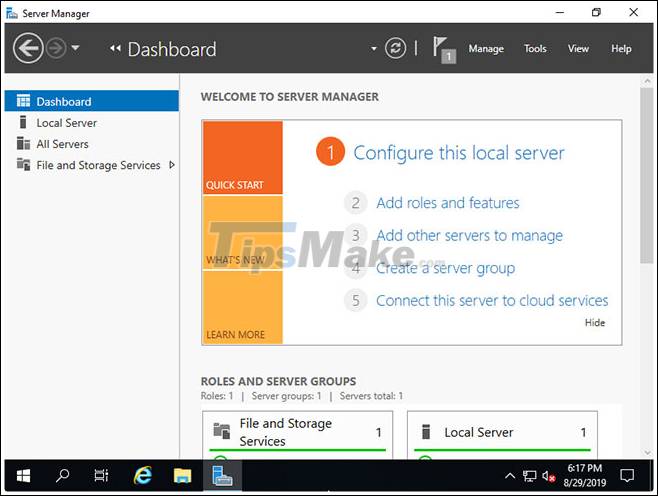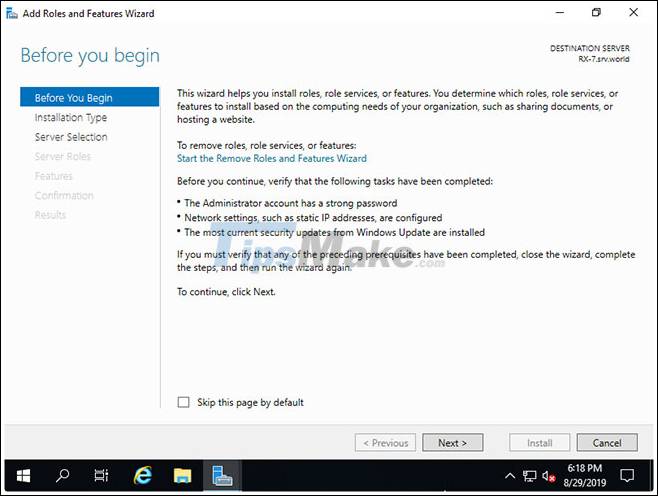How to install and use IIS on Windows Server 2019
Microsoft's new release of Windows Server 2019 comes with IIS 10. This guide will show you how to install and use IIS on Windows Server 2019.
Install IIS on Windows Server 2019
Step 1. Run Powershell as admin and install IIS.
Windows PowerShell Copyright (C) Microsoft Corporation. All rights reserved. # install IIS with admin tools PS C:UsersAdministrator> Install-WindowsFeature Web-Server -IncludeManagementTools Success Restart Needed Exit Code Feature Result ------- -------------- --------- -------------- True No Success {Common HTTP Features, Default Document, D. # verify running to access to default web site PS C:UsersAdministrator> Invoke-WebRequest http://localhost StatusCode : 200 StatusDescription : OK Content : ; outerText=; tagName=A; href=http://go.microsoft.com/fwlink/?linkid=66138&clcid=0x409}} ParsedHtml : System.__ComObject RawContentLength : 703Step 2. Run Server Manager and click Add roles and features .

Step 3. Click the Next button .

Step 4. Select Role-based or feature-based installation .

Step 5. Select the host you want to add services to.

Step 6. Check the box for Web Server (IIS) .

Step 7. Additional features are required to add IIS Server. Click the Add Features button > Next .

Step 8. Click the Next button .

Step 9. Click the Next button .

Step 10. This is the selection of Web Server features. Select the features you want to add. In this example, the default options are preserved. Of course, you can add these features after you install IIS.

Step 11. Click the Install button .

Step 12. After finishing the installation, click the Close button .

Step 13. Run your web browser and go to localhost , then you can verify if IIS is running normally.

Using IIS on Windows Server 2019
Step 1. Run Powershell with admin rights and configure the following:
Windows PowerShell Copyright (C) Microsoft Corporation. All rights reserved. # show Sites list : [Default Web Site] is only set PS C:UsersAdministrator> Get-Website Name ID State Physical Path Bindings ---- -- ----- ------------- -------- Default Web Site 1 Started %SystemDrive%inetpubwwwroot http *:80: # [Physical Path] is the Document Root PS C:UsersAdministrator> Get-ChildItem C:inetpubwwwroot Directory: C:inetpubwwwroot Mode LastWriteTime Length Name ---- ------------- ------ ---- -a---- 8/27/2019 6:57 PM 703 iisstart.htm -a---- 8/27/2019 6:57 PM 99710 iisstart.png # verify accesses : [iisstart.htm] responds PS C:UsersAdministrator> Invoke-WebRequest localhost StatusCode : 200 StatusDescription : OK Content : Get-WebConfigurationProperty -Filter "//defaultDocument/files/add" -PSPath "IIS:SitesDefault Web Site" -Name "value" | select value Value ----- Default.htm Default.asp index.htm index.html iisstart.htm # create a test page under the Document Root and verify working # [Write-Output] generates with UTF-16, so specify encoding explicitly with [Out-File] PS C:UsersAdministrator> Write-Output "IIS Default Start Page" | Out-File C:inetpubwwwrootDefault.htm -Encoding Default # verify accesses # for [curl.exe], specify extension ⇒ if not specify extension, [curl] is an Alias from [Invoke-WebRequest] PS C:UsersAdministrator> curl.exe localhost IIS Default Start PageStep 2. Run Start> Server Manager and click Tools> Internet Information Services (IIS) Manager .

Step 3. Open items in the left panel, Default Web Site is configured.

Step 4. Select Default Web Site and click Advanced Settings . , then you can confirm settings such as Physical Path (Document Root) , etc.

Step 5. Open Default Document , then can confirm the default document.

Step 6. You can see the default documents.

Step 7. Create a test page in Physical Path (Document Root) and verify permissions using a web browser.

Hope you are succesful.
You should read it
- How to install a VPN on Windows Server 2019
- How to install Active Directory on Windows Server 2019
- Introducing Exchange Server 2019, how to install Exchange Server 2019
- How to install IIS in Windows Server 2012
- Download Windows Server 2019 and discover new features
- How to install iSCSI Target on Windows Server 2019
- SQL Server 2019 - Microsoft Relational Database Management System
- Microsoft added recovery, backup, security for Windows Server 2019
May be interested
- Install Role, configure role on Windows Server 2012
 like previous versions, windows server 2012 has many associated roles. roles and features are tools you need to install or enable to complete your it administration tasks, if you don't install them, you can't do anything. in this article, we will learn how to install and configure the most important roles.
like previous versions, windows server 2012 has many associated roles. roles and features are tools you need to install or enable to complete your it administration tasks, if you don't install them, you can't do anything. in this article, we will learn how to install and configure the most important roles. - 4 basic difference between Windows Server and Windows Desktop
 windows server is the operating system for servers, servers, so it will have differences compared to the windows desktop version we still see everyday. keep these in mind when you need to choose to install windows server or windows desktop. they are also important when you need to restore, repair installation.
windows server is the operating system for servers, servers, so it will have differences compared to the windows desktop version we still see everyday. keep these in mind when you need to choose to install windows server or windows desktop. they are also important when you need to restore, repair installation. - Create VPN Server on Windows 8
 no need to install any additional applications, you can easily 'turn' your computer into a vpn server if you're using windows 8. in this way, you can share data from the computer. as a simple lan system in the form of remote access. & a
no need to install any additional applications, you can easily 'turn' your computer into a vpn server if you're using windows 8. in this way, you can share data from the computer. as a simple lan system in the form of remote access. & a - How to install Hyper-V in Windows Server 2012
 virtualization is one of the most important technological features. microsoft has invested in developing this feature and called it hyper-v.
virtualization is one of the most important technological features. microsoft has invested in developing this feature and called it hyper-v. - How to install DNS Server on Windows Server 2019
 from microsoft, the domain name system (dns) is one of the industry standard protocol sets that includes tcp / ip, along with dns client and dns server that provide name resolution services that map names to the ip addresses of computers. .
from microsoft, the domain name system (dns) is one of the industry standard protocol sets that includes tcp / ip, along with dns client and dns server that provide name resolution services that map names to the ip addresses of computers. . - How to install Owncloud server on Windows 10 (WSL)
 owncloud server is an open source cloud storage solution with multimedia playback and file sharing capabilities.
owncloud server is an open source cloud storage solution with multimedia playback and file sharing capabilities. - Install and configure Windows Home Server
 today we will introduce you to windows home server and show you how to install and configure it with other computers on your network.
today we will introduce you to windows home server and show you how to install and configure it with other computers on your network. - Install Hyper-V Virtualization on Windows Server 2008 R2
 in the following article, we will introduce and guide you a few basic steps to install and deploy the technology platform that supports virtualization of hyper-v on windows server 2008 r2.
in the following article, we will introduce and guide you a few basic steps to install and deploy the technology platform that supports virtualization of hyper-v on windows server 2008 r2. - How to install and open File Server Resource Manager in Windows Server 2012
 file server resource manager is a feature that helps system administrators manage shared folders, in terms of setting limits or expanding file restrictions.
file server resource manager is a feature that helps system administrators manage shared folders, in terms of setting limits or expanding file restrictions. - How to install Active Directory on Windows Server 2019
 one of the best features that makes windows server shine in the enterprise arena is the active directory. this single sign-on tool integrates seamlessly and easily with most microsoft products making managing users pretty easy and enjoyable.
one of the best features that makes windows server shine in the enterprise arena is the active directory. this single sign-on tool integrates seamlessly and easily with most microsoft products making managing users pretty easy and enjoyable.










 Instructions on how to install Xampp software on Windows 10
Instructions on how to install Xampp software on Windows 10 How to install iSCSI Target on Windows Server 2019
How to install iSCSI Target on Windows Server 2019 Set up Remote Desktop on Windows Server 2019
Set up Remote Desktop on Windows Server 2019 Introducing Exchange Server 2019, how to install Exchange Server 2019
Introducing Exchange Server 2019, how to install Exchange Server 2019